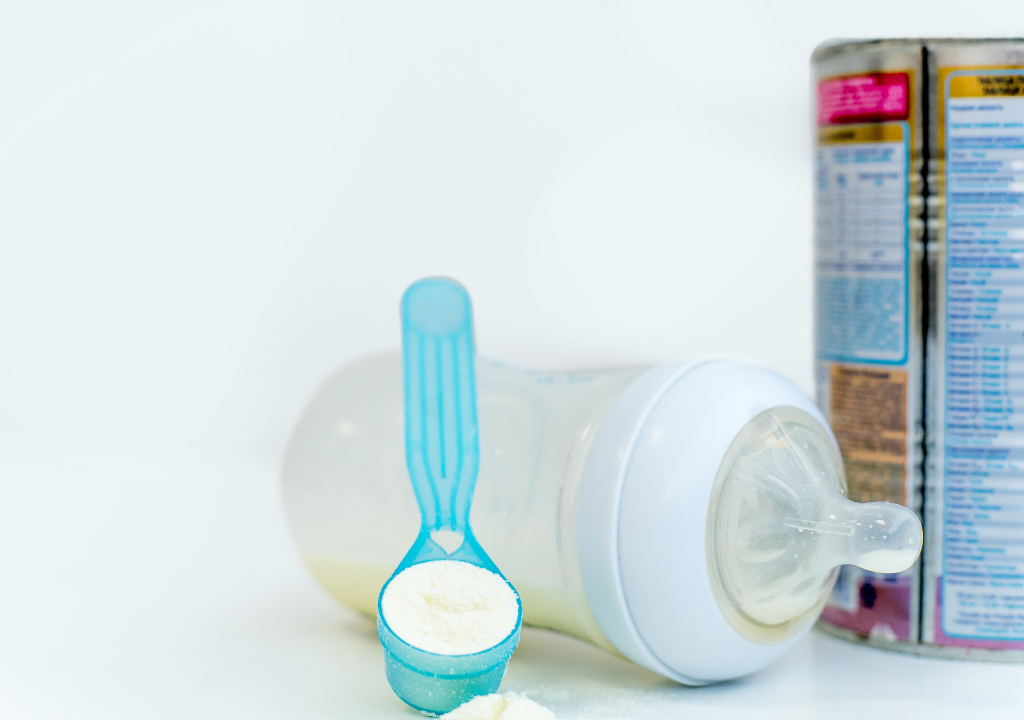
Mixing! Breastfeeding and formula feeding aren’t mutually exclusive. Many parents use both breast milk and formula mixing to make sure their baby gets the nourishment they need to thrive.
The Pediatrics recommends exclusive breastfeeding for six months, meaning giving no other foods or liquids except breast milk. The Pediatrics also recommends continued breastfeeding until 2 years old or beyond if both mother and baby want to.
But this isn’t possible for all families. Most of babies are breastfed exclusively through 6 months old. A large number of babies (58 percent) are breastfeeding non-exclusively at 6 months old, and about 35 percent are still breastfeeding at 1 year old.
Many breastfeeding parents use formula to supplement their little one’s feedings, perhaps adding a bottle of formula overnight so their partner can do a late-night feeding or using formula to fill in the gaps when they’re unable to pump enough to send to daycare mixing. Reasons for supplementing with formula include low milk supply and other breastfeeding challenges. Or, your baby’s doctor may recommended it if your baby isn’t gaining enough weight.
Tips for mixing breast milk and formula
If you’re feeding your baby breast milk and formula (combination feeding), here are some tips to help you do it safely:
- Talk to your baby’s doctor about your plans for combination feeding so they can advise you on adding formula to your baby’s diet, and on how much formula they’ll need.
- It’s a good idea to make sure that breastfeeding is going smoothly before adding formula and bottles to the mix. If possible, wait until your baby is three or four weeks old before giving them a bottle.
- Try a supplemental nursing system, or SNS, for very young babies. This may be an option if your doctor is concerned about your baby’s weight gain and suggests combining formula and breast milk before 3 or 4 weeks. This supplemental system allows parents to offer pumped breast milk or formula through a micro-tube at the breast.
- You may want to nurse your baby, then offer them formula an hour or two later. This is the best way to protect your milk supply, since breastfeeding supply depends on demand. The more your baby nurses or you pump, the more milk your body will produce.
- Start cutting back on breastfeeding sessions and giving formula gradually, if you can. This will help you avoid issues like a sudden drop in milk supply, engorgement, clogged milk ducts, and mastitis.
- Practice paced bottle feeding. This method of feeding allows your baby to control how much and how quickly they eat. You’ll hold your baby more upright and take regular breaks every 20 to 30 seconds to burp them and see if they’re satisfied. Paced feeding is more similar to breastfeeding, and may help you switch back and forth more easily between nursing and giving formula.
Can you mix breast milk and formula in the same bottle?
It’s not ideal to mix breast milk and formula in the same bottle. Since you’ll need to toss any unfinished bottles, your breast milk could go to waste when combined with formula. Ideally, parents will breastfeed first, then offer a bottle of any available pumped milk, and then supplement with formula as necessary.
However, there are times when it might make sense to mix both breast milk and formula in the same bottle – for instance if you’re trying to help your baby get used to the taste of formula. If this is the case, begin by preparing the formula according to the directions on the package. Then, you can mix the prepared formula with breast milk in the bottle.
What about fortifying breast milk with formula?
Never add formula powder to breast milk, or use breast milk instead of water to make formula. The most common types of formula (powdered and liquid concentrate) must be mixed with water according to the manufacturer’s directions in order to be safe for your little one.
Breast milk has all the nutrients your baby needs, and so does formula. There’s no need to “fortify” breast milk by adding formula powder to it. And while it might seem beneficial to use breast milk in place of water when making formula, this practice can be dangerous for your baby.
Always prepare formula exactly as directed on the packaging. Both over-diluting or under-diluting it poses health risks to your baby.
Read more about


Add a Comment